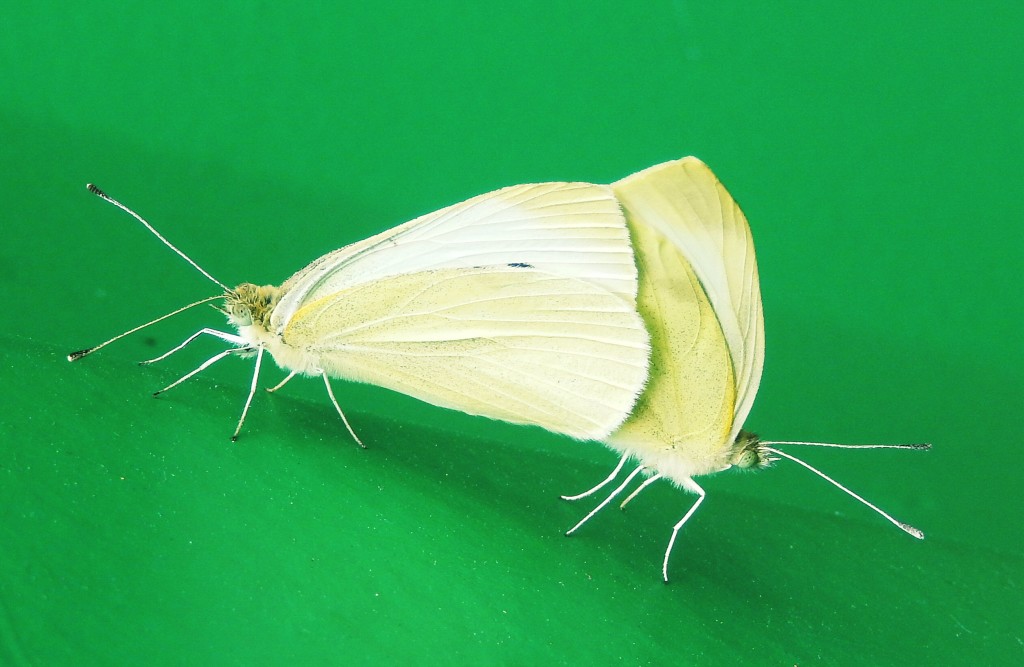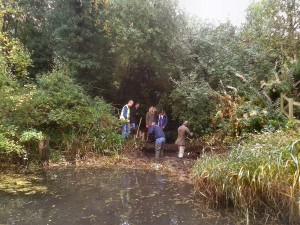
Category Archives: Conservation
Making Hay While the Sun Shines in Gunnersbury Triangle
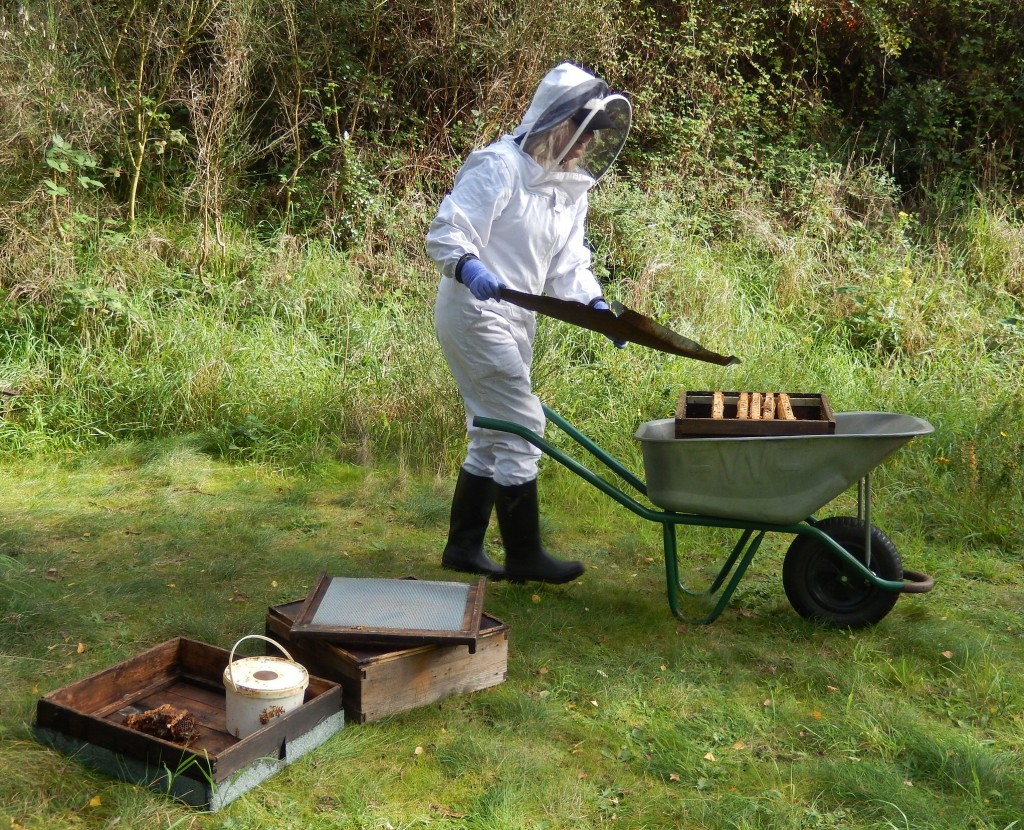
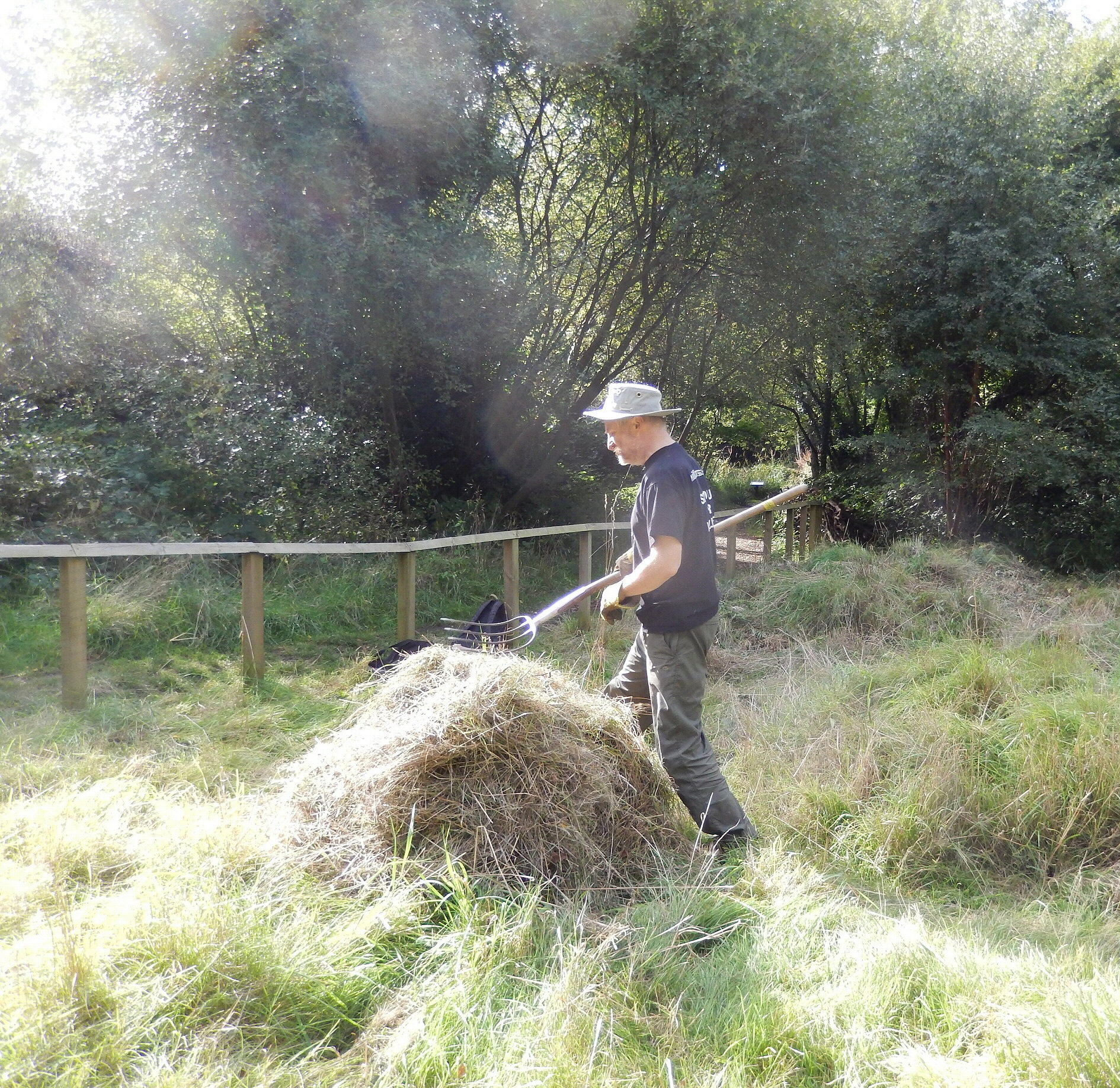
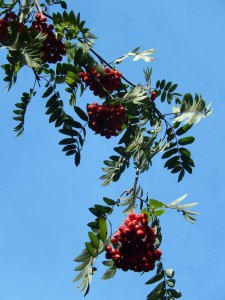
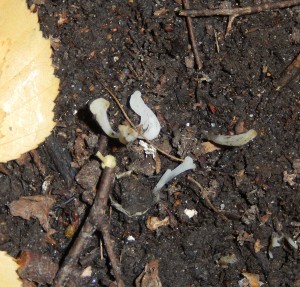
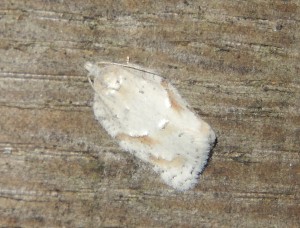

Meeting George Monbiot: Rewilding Britain

Yesterday I went along to Kew Gardens’ new book festival to hear George Monbiot, the author of Feral: Rewilding the land, sea and human life (Penguin, 2014). He was genuinely inspirational.
We sat down in neat rows on elegantly stiff, lightly-made wooden chairs in the beautiful Nash Conservatory, the sun streaming right into our eyes; Monbiot’s first words were to apologise humorously for the rather bright lighting. The two large computer screens displayed the festival’s welcome screen, and stayed that way: Monbiot spoke without slides, and without notes. He was clear, sharp, warm, and where appropriate really quite entertainingly rude about government policy.
Britain’s “trashed” uplands
He told us how his excitement at moving to the Cambrian Mountains turned to puzzlement and then despair as he realized there were no trees: no birds: no butterflies: no bees: no flowers except Tormentil, indicator of poor soil. He directly and simply told us complicated stuff, like the Structural Heterogeneity of the rainforest, a whole architecture of ecosystems with multiple niches for species of every description. He reminded us that Britain has less tree cover than almost anywhere else in Europe – 12% against an average of 37%. His mountains had been shagged to death by sheep, ruined by the white plague; other mountains (Scotland, say) had been just as well trashed by management for shooting grouse or red deer. Britain had the second biggest landholdings of any country – after Brazil. Why? Because farm subsidies reward the largest landholders, the oil sheikhs and Russian oligarchs, the world’s luckiest landlords, paid for doing nothing but keeping the land in “agricultural condition”. And that meant? Keeping it free of what the bureaucrats call “permanent ineligible features”, in other words, trees. Britain’s mountains are wet deserts, profitable only to the rich. And they are paid to keep the land species-poor.
Even the nature reserves have “key indicator species” (Monbiot was really warming to his theme now, putting the boot in) like Red Grouse, Ring Ouzel, Skylark, Meadow Pipit: the few birds that thrive in bare open moorland (and there were hardly any of them, he said). Montgomeryshire’s claimed “really wild” jewel in the crown reserve was “identical” to the rest of the cold wet desert. It, like the rest of it, was maintained by a programme of cutting, burning and grazing to prevent trees and bushes from taking over. The “undesirable species”? They were, erm, native trees like Hawthorn and Birch, the pioneering colonisers that pave the way for all the trees of the forest, all the way up to, um, the beautiful natural primary forest of the Wildwood, complete with glorious epiphytic ferns like Polypody, great trailing beards of lichen, all the mosses and liverworts and flowers and invertebrates and beasts of every size that you’d find in a rainforest. It’s a circular argument: you need grazing to maintain “favourable condition”; and that is measured by indicator species which are the ones found on bare moorland; which you’ve defined as what favourable condition is. Only, that isn’t what the Eurocrats actually asked for: they specified “favourable ecological situation”, which might mean … wildwood. Quite the opposite.
Protecting the ranchers from the rainforest
Now for the sting: if the ranchers of Brazil start a program of cutting, burning and grazing to destroy the rainforest, leaving bare meadows for their cattle, there’s an international outcry. But in Britain, it’s the required management regime for our best nature reserves! We’re protecting the ranchers from the rainforest. Why is mid-Wales bare and open? Because for 200 years it was devastated by lead mining; and after that, grazed to nothing by sheep. The white death only need to be present at one sheep per ten Hectares (hardly any, basically) to kill all the new tree seedlings: young saplings are delicious and nutritious, and sheep greedily and selectively seek them out.
Well, I’m not going to try to recap the whole talk, let alone the whole book, which I’ve already reviewed for you. Rewilding, Monbiot says with simple and direct plausibility, is informed by Remembering. And our memories are terribly short. Back in the 18th Century, Oliver Goldsmith described the massive shoals of Herring in our waters; harried by enormous numbers of Tuna, Porbeagle, Sperm Whale, Fin Whale. Yes, there was in the past few centuries, recorded by careful scholarly intellectuals, a thriving Tuna fishery at Scarborough. Not the Tonnara in Sicily, now defunct; not the Tuna fishery of Monterey Bay with its Cannery Row, now a marvellous Aquarium (I have the T-shirt to prove it); but right here. Like our coast-to-coast temperate rainforest, it’s practically all gone.
Trophic cascades
BUT… we can have it back! “Amazing things can happen”, said Monbiot. There are Trophic Cascades, life pouring down from the top in an ecosystem. How? The classic example is from America’s Yellowstone National Park. The wolves were removed in the 1920s to “improve” on nature, allowing more deer (and better hunting). Only, it didn’t work out like that. The park, deprived of the wolf, became steadily poorer in wildlife. Then in 1995, after lengthy argument (very lengthy argument, in fact), the wolf was brought back in small numbers.
The effect was dramatic. Within six years, the trees were FIVE TIMES taller. The wolves had scattered the deer from their grazing haunts down by the rivers. Saplings sprouted. Trees shot up. Beavers felled trees to make dams and lakes. Waterside plants flourished. Fish, invertebrates, amphibians, reptiles and muskrats appeared all over. The wolves killed coyotes. Small animals appeared all over. The trees stabilised the banks of the rivers. The rivers meandered less; erosion patterns altered. Bison multiplied among the larger trees. Fruiting shrubs blossomed and bore berries; bears ate quantities of them, and fish. The wolves changed the landforms, planted trees, made flowers bloom. Everyone, including professional ecologists, was astonished.
Rewilding Britain
What could we have here? Getting the moose, bison, bear and wolf back may take some time here in tightly-buttoned Britain. Elsewhere in Europe, wolverines are coming back from the far north; millions of beavers are making dams in dozens of countries; lynx are being reintroduced with minimal fuss. Everyone except us thinks it’s NORMAL. Everyone except the British governing elite (and their landowning friends and relatives) wants to see beavers and wild boar in our countryside: lynx, too.
Can we have wildlife and people? Sure.
Can we have wildlife and subsidies for grouse moors and a “stupid” Common Agricultural Policy? No. Even the supposedly “green” part of the CAP is insane – we pay 55 billion to farmers to do nothing with the land (except destroying trees), then we pay them a bit more to put a tiny bit of wildlife back on a tiny part of it: and even that part is basically worse than useless.
Conservation sites have to be resilient, argues Monbiot, self-willed, running nature’s own processes, if they are to survive the shocks that are coming. All we have to do is to let nature get on with it.
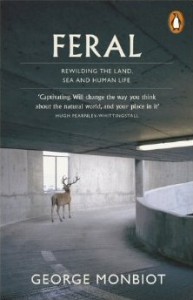
Hope
At the end we all trooped to a table where Monbiot signed our copies of Feral (here’s my book review), in my case a clean but pretty well-thumbed copy. He wrote “To Ian, with hope, George Monbiot”, and I went home in the sunshine thinking, yes, with hope: “conservation” sounds worthy and dull, like aunties with conservatories in their garden, or conservative opinions, or carefully conserving dusty artefacts against moth and museum beetle. But hope: hope that Britain will gain new and better kinds of nature reserve, full of deer, and beaver, and wild boar, and lynx, a sparkle of excitement at glimpsing what the wildwood was really like.
Wasp Spider arrives in Gunnersbury Triangle
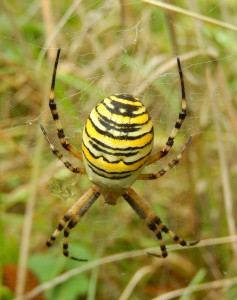
Right in front of Mike the new conservation officer was a Wasp Spider. Of course, arriving late after working on scenarios for the new hut, I noticed it – her – before he did. The species only arrived in Britain about 15 years ago, and it’s certainly spreading.
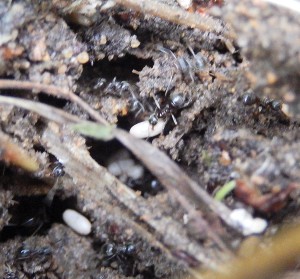
Anthill ants are supposed to be minute, yellow, and never appear above ground. If so, these weren’t them. While we were digging brambles out of the anthill meadow, as gently as possible because the anthills are said to be one of the best features of the reserve, we couldn’t help disturbing some nesting ants a little. They seem to be black with grey abdomens; and as you can see, they quickly picked up their white cocoons and carried them off to safety. They certainly look as if they’re the owners of the anthills, but since the anthills are supposed to have been made by little yellow ants, perhaps the black-and-grey ones are just enjoying the resulting environment.
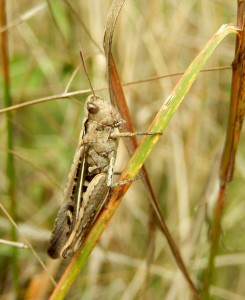
Several inch-long grasshoppers took a look at us.
Creag Meagaidh NNR
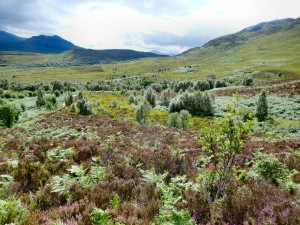
After a morning sheltering inside from the pouring rain, it cleared and I drove down to Creag Meagaidh, the enormous national nature reserve that fills a watershed from Loch Laggan up to the named mountain. The sun shone nearly all the time despite billows of cloud to the south. The hills were blue, setting off the shining grey-green of the birches, the russet of the heather – the Ling just coming into bloom now – and the bright yellow-green of the mossy grass.
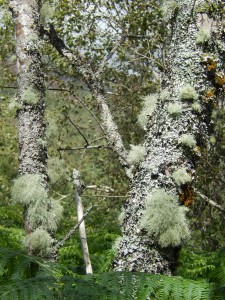
The Downy Birch is a stockier tree than the Silver Birch, tough enough to survive mountain winters, and home to a rich variety of lichens including Usnea beard lichens, bristly Ramalina, dark stringy Alectoria jubata (now renamed Bryoria fremontii), and various leafy Parmelia species that yield orange dyes used in Harris Tweed.
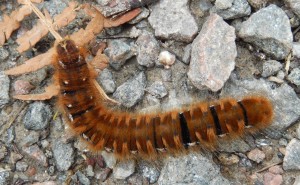
Large handsome caterpillars of the Northern Eggar Moth, the Scottish form of the Oak Eggar (Lasiocampa quercus), up to 3 inches (75 mm) long and nothing to do with oak trees, wriggled across the path, their rufous hairs warning off predators. They feed on Heather and Bilberry.

In every patch of damp grassland, Scotch Argus butterflies skittered, looking very dark in flight. They are hard to approach as they constantly chase each other off from their territories, but eventually I found one that stayed settled long enough to creep up to. Close up, the upper side is a rich brown, with red patches around the wing edges dotted with black circles that have white centres.
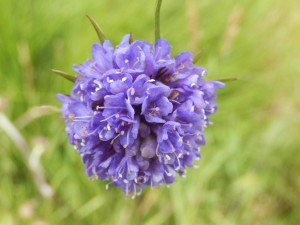
A few bumblebees, some of unfamiliar species, visited the Devilsbit Scabious (Scabiosa succisa) briefly. Large Syrphid hoverflies basked on the paths.
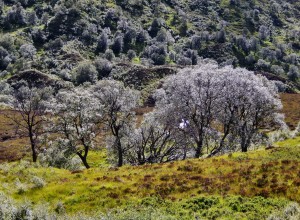
Further up the valley, a fine group of birches actually glittered in the bright sunlight, the water of the stream shining silver behind them.
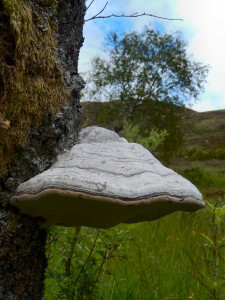
A dead birch, stark against the sky, supported stout Birch Bracket polypores, handsomely whitish-grey above, yellow ochre below.
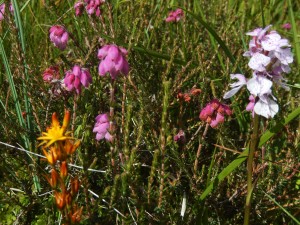
In the boggier patches, Bog Asphodel and Marsh Orchid flowered among the Bell Heather.
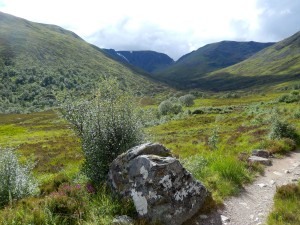
I turned the corner of the valley to see snow still lying in the deep, north-facing gullies on Creag Meagaidh, and the striking notch of the col that gives access to the mountain ridge.
A day for signs (signboards and mimics)

It was a day for signs: we worked all morning digging two deep post-holes for a new welcome signboard beside the ramp path, telling stories as we dug down through dry soil, pebbles and then soft clayey subsoil. Eventually we were deep enough and level enough to pop the sign in, and with nothing more than the spoil, pebbles, and a spirit level and a bit of tamping, we had a fine new signboard up. As if by magic, the TV camera team from ChiswickBuzz arrived to film us holding up spades, a Green Cross banner (some sort of quality of service award), and asking us to cheer improbably, so we shouted 1-2-3 Hooray! and waved spades like idiots, and the camera crew looked happy and wandered off.
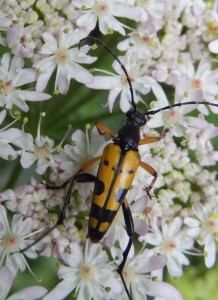
There were some bright black-and-yellow insects about pretending not very convincingly to be wasps, but their warning signs seem to work pretty well. After lunch we came back past the signboard to do a butterfly transect, and we nearly cheered as a visitor took a good look at the signboard. We joked that with an apostrophe missing, we’d have to dig the sign out and send it back for a refund.
On the transect we had good numbers of butterflies, but without so much sunshine it was without the masses of Gatekeepers of a fortnight ago. There were a pair of Commas, a Red Admiral, a Brimstone, and plenty of Small Whites, Speckled Woods, Holly Blues and Gatekeepers. A pair of (Migrant or Southern?) Hawkers scooted about from the hut to the ramp; down by the pond was an exuviae of something like a Broad-Bodied Chaser; a Common Darter sunbathed on the boardwalk, and a pair of Azure Blues wandered above the now happily full pond, laying eggs. The reserve echoed to the crash of demolition from the High Street.
Clouds of Butterflies … in London
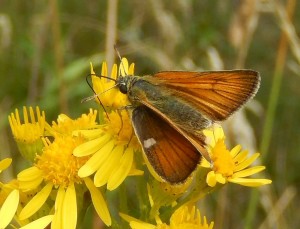
Well, what an exciting day in nature. In London, too. The meadows are now as dry as we’ve ever seen them; and they’re full of butterflies. The Small Skippers have flown; in their place are plenty of Essex Skippers, on an increasing amount of Ragwort.
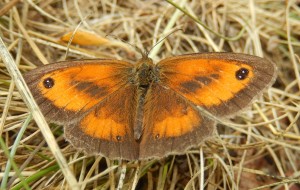
They are accompanied by clouds of Gatekeepers: we must have seen 100 of them, with 35 counted on one leg of the Butterfly Transect alone (going along to the beehive behind the Anthill Meadow). And good numbers of Meadow Browns (a dozen or so) and Small Whites; with twenty or thirty Holly Blues, they were high in the woods, visiting leaves, even on the ground.

A male Sparrowhawk perched on a dead branch above the pond boardwalk.
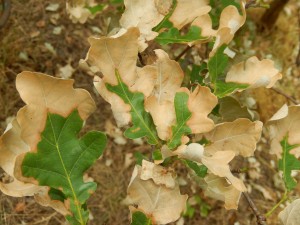
Signs of drought were everywhere: the pond is really low, but the brief rains of the last few days have brought levels back up a little. We spend a while giving 7 barrowloads of water to the planted birches on the embankment, and even rescued a few small oaks that were really suffering. The holm oaks, from the Mediterranean maquis, however looked perfectly comfortable: presumably with their waxy leaves and closed stomata, they are barely growing in the dry season.

We fixed up a trellis on battens bolted to the extremely hard steel of the green hut; it took forever to pierce the metal, but after that it was easy to do up the bolts and screw the trellis to the battens.
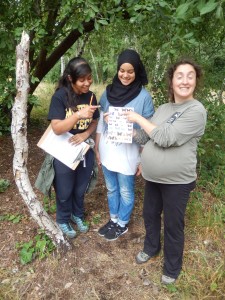
And yes, the butterfly transect was crowned by a confirmed sighting of an insect we’d felt sure must be here: a Purple Hairstreak. One sat on a low-hanging Oak leaf for us to check with binoculars and shaky camera. The streaked wings with their tiny tails could not be mistaken. The conservation officer was … visibly pleased. We also saw what seems to have been a Beautiful Carpet Moth – again, the photo was distant but we all saw it with binoculars.
It was hot and humid, and we worked quite hard, but it was a beautiful and memorable day.
Birds, Bugs, Blooms in Bornholm (Denmark)
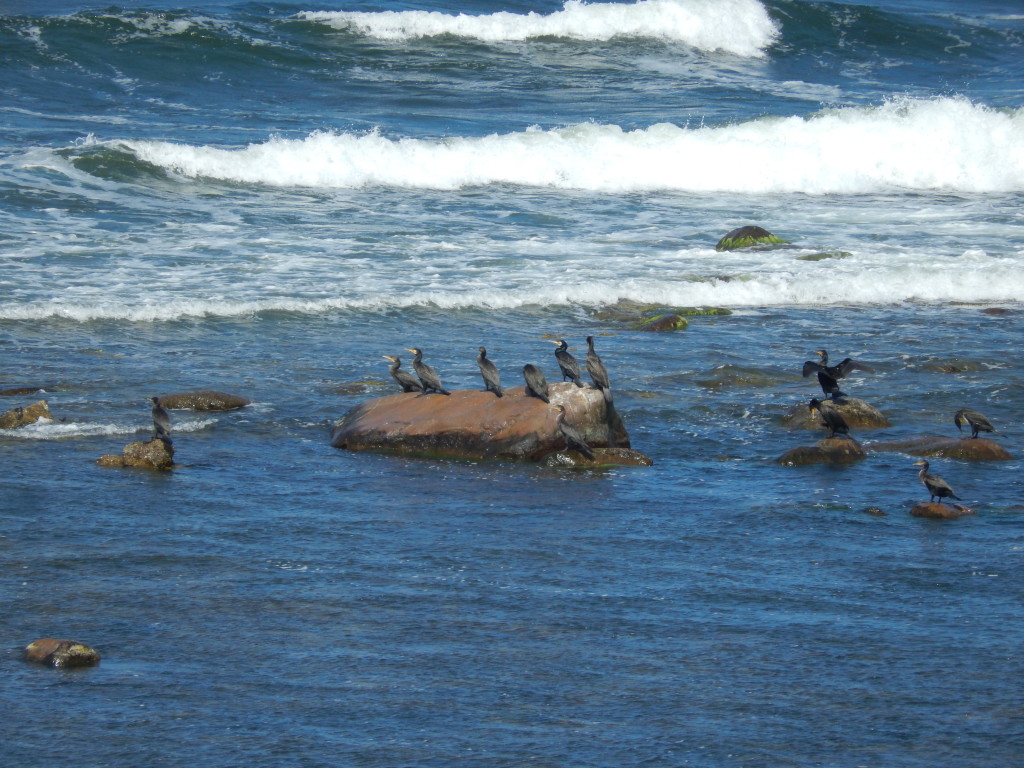
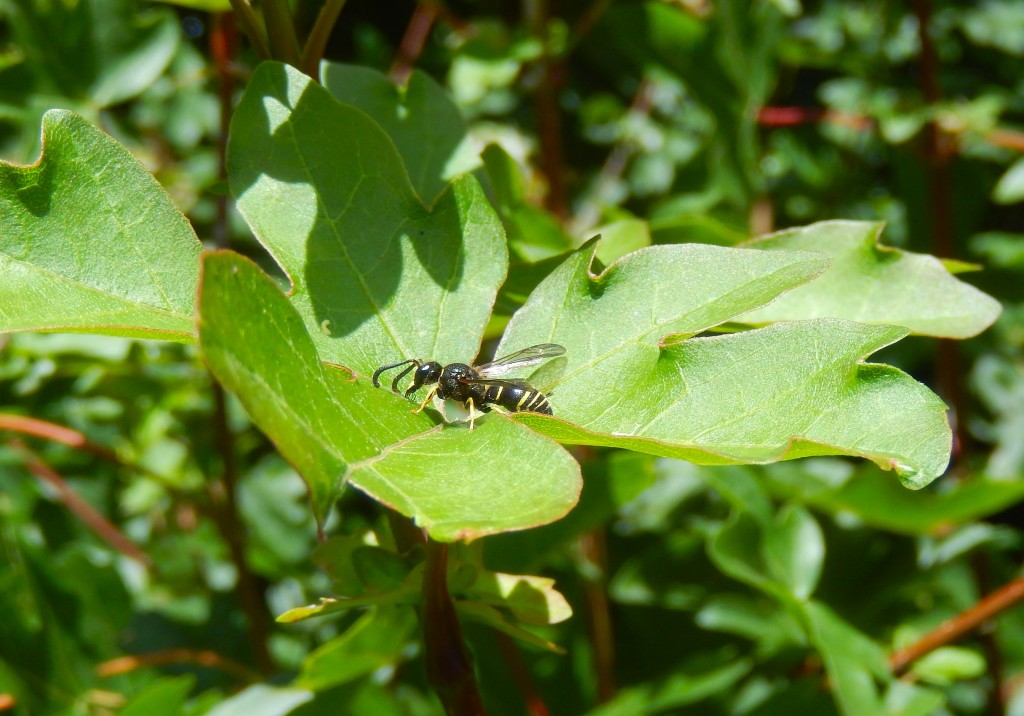
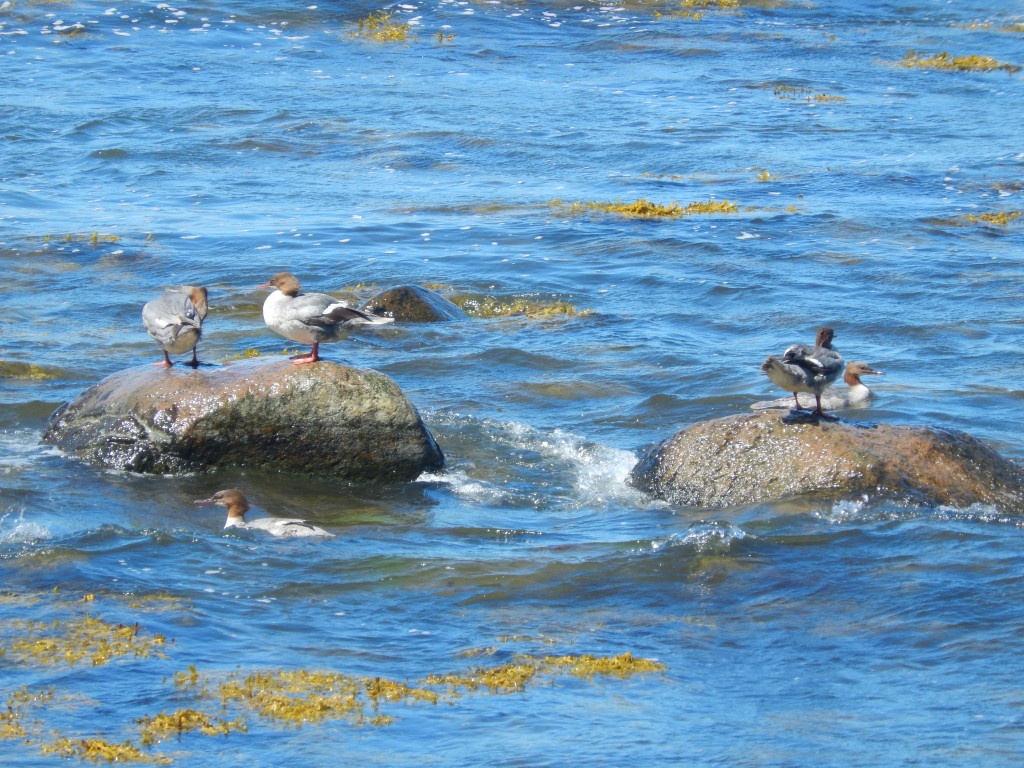
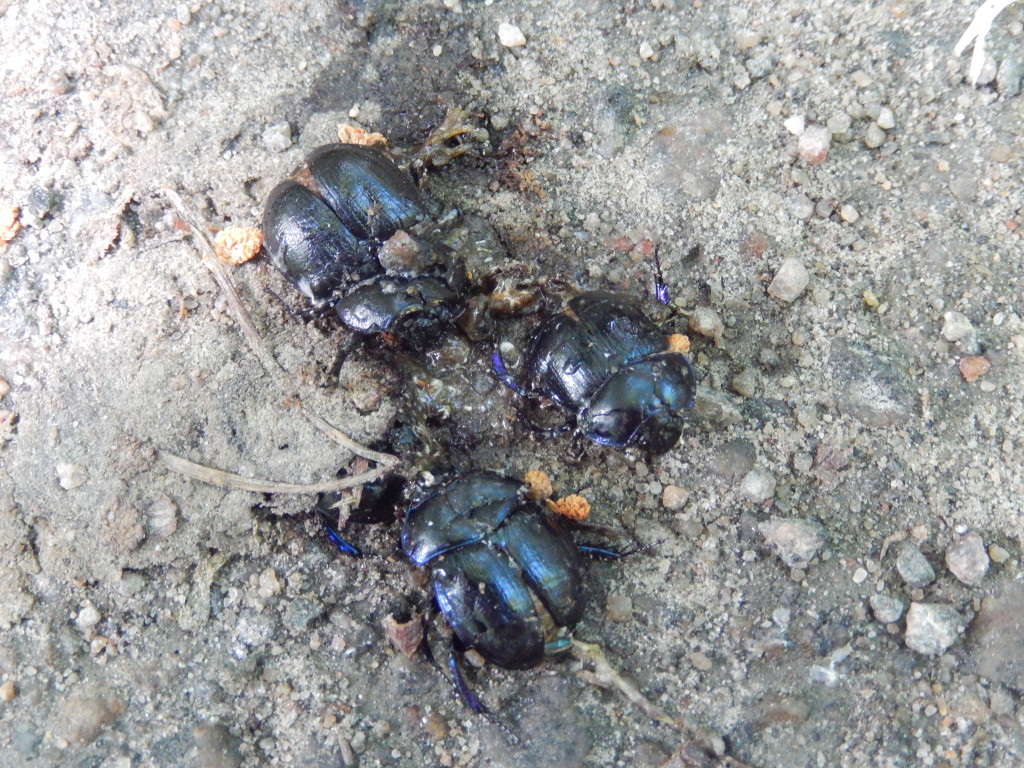
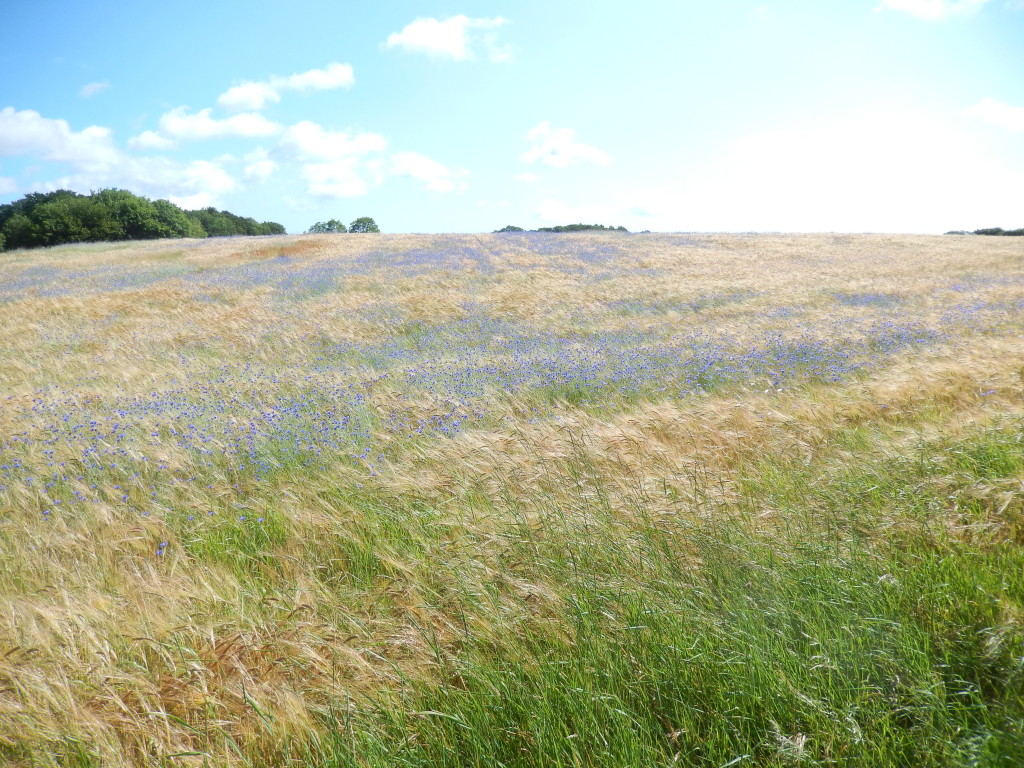
Bornholm is in some ways as Britain was half a century ago or more: there are still swathes of cornflowers and poppies, though many of the fields are plainly weed-free except for narrow margins. The sky over arable fields and set-aside is loud with the song of skylarks; the hedges are full of the cheerful little-bit-of-bread-and-no-CHEESE song of yellowhammers. Swallows race in numbers low over the corn; the towns are busy with house sparrows, swifts and house martins, the many handsome old houses and churches offering plentiful nesting places to suit all parties. The woods held good numbers of blackcap, with willow warblers in the more open areas, a chiffchaff or two, plenty of whitethroats in scattered bushes, a garden warbler or two.
Some things are simply modern, despite the unspoiled rural look of the island: butterflies seem to be few – red admirals, speckled woods, peacocks, small tortoiseshells, meadow browns, and what I think was a fritillary over a marsh-fringed lake – it was quite big and fairly pale, roughly like a dark green: perhaps it was a marsh fritillary, but I couldn’t stay to find out. It was somewhat windy all week, so perhaps there are many more species on windless days, but I rather doubt it (and wind does seem rather usual on the island).
Of course in many ways it is quite different. The presence of eider ducks and goosanders in numbers on the (brackish) Baltic Sea, along with the occasional mute swan and mallard (and a less surprising shelduck), is strikingly unfamiliar. The crows, as in Scotland, are a reminder that this is the North: handsome grey-mantled hooded crows instead of their all-black carrion crow cousins; and there are rooks in numbers all over, including in the villages, boldly scavenging.
A Butterfly Blessing
Large Skipper and Ichneumon in Gunnersbury Triangle
Down at the reserve today, the first Skipper of the year, basking on a reed by the pond (with Azure and Large Red Damselflies too). It must be a Large Skipper from its size and pattern: uncommon in the reserve.
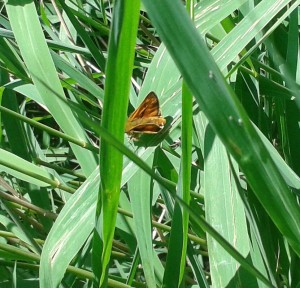
Up on the ramp, a Red Admiral; and this Ichneumon wasp, which looks very much like Gasteruption jaculator, a fine parasitoid with an ovipositor as long as her head, thorax and abdomen together. She was inside the hut trying to escape through the window; she is black all over, except for the front of her abdomen which is red, and the tip of her ovipositor, which is white. Her wings are nearly transparent with a hint of brown.

We spent the morning fixing path edgings – poles of elm, with handmade wooden pegs, sharpened to stakes. A foreign couple came along and asked if we were preparing for Vampires: perhaps they were from Transylvania, who knows.
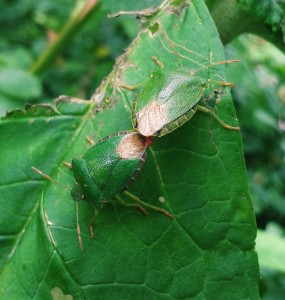
In the afternoon we repaired the gaps in the fence where vandals have started jumping over and running down the bank. We hammered in an enormous metpost with a tall square oak post – we had to bring the stepladder to reach the top to drive it in with the round post-hammer – and we had to shave off the edges so the hammer fitted over the post! Then we twisted wire supports and barbed wire to repair the gaps, and hammered extra-large staples into the posts to fix the wire. It was hot and hard work but we’ve fixed a definite problem. Happily the rest of the fence has become totally overgrown with brambles and bindweed, with leafy branches reaching down to it, so it seems unlikely anyone will climb over it there.

